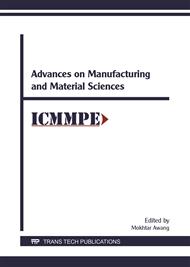[1]
T. Kaneeda and M. Takahashi, CFRP Cutting Mechanism (1st Report)―Surface Generation Mechanism at Very Low Cutting Speeds―, The Japan Society for Precision Engineering, Vol. 55, No. 8, pp.1456-1461, 1989 (in Japanese).
DOI: 10.2493/jjspe.55.1456
Google Scholar
[2]
S. Hanasaki, J. Fujiwara, T. Kawai, M. Nomura and T. Miyamoto, Study on Tool Wear Mechanism of CFRP Cutting 2, The Japan Society of Mechanical Engineers, Series C, Vol. 71, No. 702, pp.719-724, 2005 (in Japanese).
DOI: 10.1299/kikaic.71.719
Google Scholar
[3]
T. Inaba, A. Hosokawa, T. Ueda, T. Furomoto and R. Tanaka, End milling of CFRP - High-quality machining with high helix end mill -, Proceedings of the Japan Society for Precision Engineering Autumn Meeting, pp.169-170, 2012 (in Japanese).
DOI: 10.1016/j.cirp.2014.03.084
Google Scholar
[4]
H. Tanaka, K. Shimizu, S. Obata, R. Takizawa and K. Yanagi, Experimental study on planetary mechanism drilling for carbon fiber reinforced plastic (1st Report) - Influence of tool shape and machinability of CFRP -, Journal of the Japan Society for Precision Engineering, Vol. 79, No. 8, pp.761-765.
DOI: 10.2493/jjspe.79.761
Google Scholar
[5]
H. Tanaka, K. Ota, H. Takeda, R. Takizawa and K. Yanagi, Experimental study on planetary mechanism drilling for carbon fiber reinforced plastic (2nd Report) - Development of inclined planetary milling spindle unit -, Journal of the Japan Society for Precision Engineering, Vol. 80, No. 3, pp.297-301.
DOI: 10.2493/jjspe.80.297
Google Scholar
[6]
T. Yashiro, Study on Cutting Mechanism in Milling Process of Carbon Fiber Reinforced Plastics (CFRP), Dr. Dissertation, Tokyo University of Agriculture and Technology, Japan, pp.1-157, 2014 (in Japanese).
Google Scholar
[7]
T. Kaga, E. Shamoto, J. Tamura and M. Zaitsu, Two-section inclined end-milling to realize high-efficiency trimming of CFRP, Journal of the Japan Society for Precision Engineering, Vol. 80, No. 2, pp.183-190, 2014(in Japanese).
DOI: 10.2493/jjspe.80.183
Google Scholar
[8]
T. Higaino, T. Aoyama and H. Ogawa, Study on end milling of CFRP with coolant and cemented carbide end mill, Journal of the Japan Society for Precision Engineering, Vol. 81, No. 4, pp.333-338, 2015 (in Japanese).
DOI: 10.2493/jjspe.81.333
Google Scholar
[9]
S. Hanasaki, J. Fujiwara, M. Nomura and T. Kawai, Cutting Mechanism of CFRP, Preprint of 71st National Meeting of The Japan Society of Mechanical Engineers, No. 930-63, pp.207-209, 1993 (in Japanese).
Google Scholar
[10]
H. Takeyama, Cutting Process, Maruzen Publishing Co. Ltd., p.76, 1982 (in Japanese).
Google Scholar


